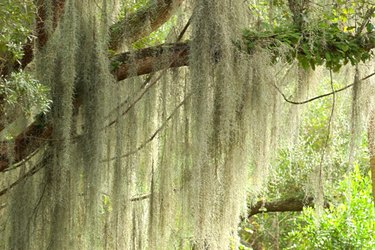
Pineapple (Ananas comosus) and Spanish moss (Tillandsia usneoides) are closely related plant species. They are bromeliads, which are flowering plants with origins in the New World. The Spanish moss range is the largest natural growing zone of all bromeliads -- extending from the American Southeast all the way to central Argentina -- in U.S. Department of Agriculture plant hardiness zones 8 through 11. Although it may look like a silvery fungus or lichen, Spanish moss is an epiphyte that grows on other plants, dangling as a thin chain of small, slender leaves. It does not harm the plant on which it grows.
Spanish Moss Range
Video of the Day
In the United States, the Spanish moss growing zones range from sea level to elevations of 985 feet. It naturally grows in the tropical Southeast, from the coastal plains of southeastern Virginia to central Georgia, west to southern Arkansas and south to the southern tip of Texas. Spanish moss's natural range is limited by winter cold on its northern fringes and aridity on its western edges. The heat and dryness of the Southwest are not conducive for growing Spanish moss, even in garden settings.
Video of the Day
Cold Hardiness of Spanish Moss
Spanish moss, sometimes called graybeard in the Deep South, survives outdoors where winter temperatures do not drop below 15 degrees Fahrenheit. Prolonged exposure to temperatures in the 15 to 25 degrees range can kill strands of leaves through desiccation, especially if ambient humidity is low and winds are present. Spanish moss cloaked over tree boughs with evergreen leaves are most protected from cold as compared to those dangling from deciduous tree branches.
Light Requirements of Spanish Moss
Within its native growing range across much of the mild-winter areas of the Americas, Spanish moss is found in habitats with bright light. The minute silvery scales on the leaves, called trichomes, allow plants to tolerate nearly full sun exposures in the highest branches of trees and palms. Full sunlight does dry out the Spanish moss leaves more quickly, especially if the air is arid. Usually, Spanish moss grows in dappled partial sun to partial shade across a tree canopy. Too much shade slows growth or prevents plants from sprouting and surviving.
Moisture Needs of Spanish Moss
Unlike the "tree moss" species (Climacium spp.), which grow on the soil in moist and swampy conditions, Spanish moss cannot live in soil, nor can it survive submerged in water. However, high humidity prevents the thin leaves and stems from dying, especially in summer. During the cooler and lower light intensity of winter, Spanish moss doesn't need as high of ambient humidity to survive, even if exposed to a lot of direct sun rays.
The trichomes on the leaves absorb moisture and nutrients from the air and rainfall. The long stems grow up to 20 feet long under ideal conditions, providing numerous tiny leaves to catch the rain as it flows over the plant on its way to the ground.
From spring to fall, when temperatures are above 80 degrees Fahrenheit, rainwater helps plants grow. The rain must flush through the leaves and strands but promptly drain away. Overly wet clumps of Spanish moss can rot if the leaves stay too wet.